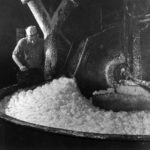In November 2017, Max Moskal, Principal Engineer, and Ron Lansing, P.E., Consulting Engineer with M&M Engineering Associates, presented the following materials at the TAPPI PEERS Conference in Norfolk, Virginia. One of the papers will be published in an upcoming issue of the TAPPI Journal**.
“A Hundred Years of Corrosion in the Pulp & Paper Industry,” Max Moskal**
“Insights on the Panama City Digester Explosion,” Max Moskal
“Service Thinning of a Duplex Stainless Steel Digester: Dissolving Pulp Process,” Ron Lansing and Max Moskal
Below are some highlights from Mr. Moskal’s presentations.
With 10 technical tracks and 37 technical sessions, there was plenty of choice for delegates. In the equipment reliability solutions session, Max Moskal, M&M Engineering Associates, gave a fascinating look at 100 years of corrosion in the industry.
Moskal went over the changes of equipment through the years. For example:
- From 1940 to 1950, kraft pulping overtook sulfite and the kraft process is less corrosive.
- Hydrosulfite brightening was introduced, promoting thiosulfate and helping to lead to increased white water corrosivity.
- Wastewater recycling began in the 1950s, which led to a buildup of ions in the system and, therefore, more corrosion.
- High-pressure recovery boilers were introduced in the 1950s, and recovery boiler explosions became an issue. Later, recovery boiler firing was done at higher temperatures and dry solids content went from 65 percent to 85 percent.
- In the 1960s, the Kamyr continuous digester was introduced and about 100 were installed between 1965 and 1970 alone.
All of these changes led to corrosion “events” affecting batch and continuous digesters, bleach plant washers, piping, the paper machine, and recovery boilers.
Though many of these problems were solved or reduced, the industry has not kept up the fight against corrosion. Moskal pointed out that there were 47 corrosion professionals employed by the various pulp and paper companies and research institutes between 1980 and 1990. In 2009 (and probably today), there were 10.
The direct cost of corrosion-related issues to the industry is estimated at 2.7 to 4.7 million tons/yr., Moskal said. It is estimated that 50 percent of corrosion costs can be avoided with known technology.
In conclusion, he said that it is difficult to calculate the cost of corrosion. It is hard to justify corrosion control actions; an ROI is needed. Equipment in a mill is often replaced piecemeal. Small companies have limited resources.
A 2016 NACE study has good information on corrosion management and life cycle corrosion cost estimates. “We have been ineffective in getting information to the right people in the industry to control corrosion.”
To view the full PEERS in Review (2017), visit TAPPI PEERS.org.


